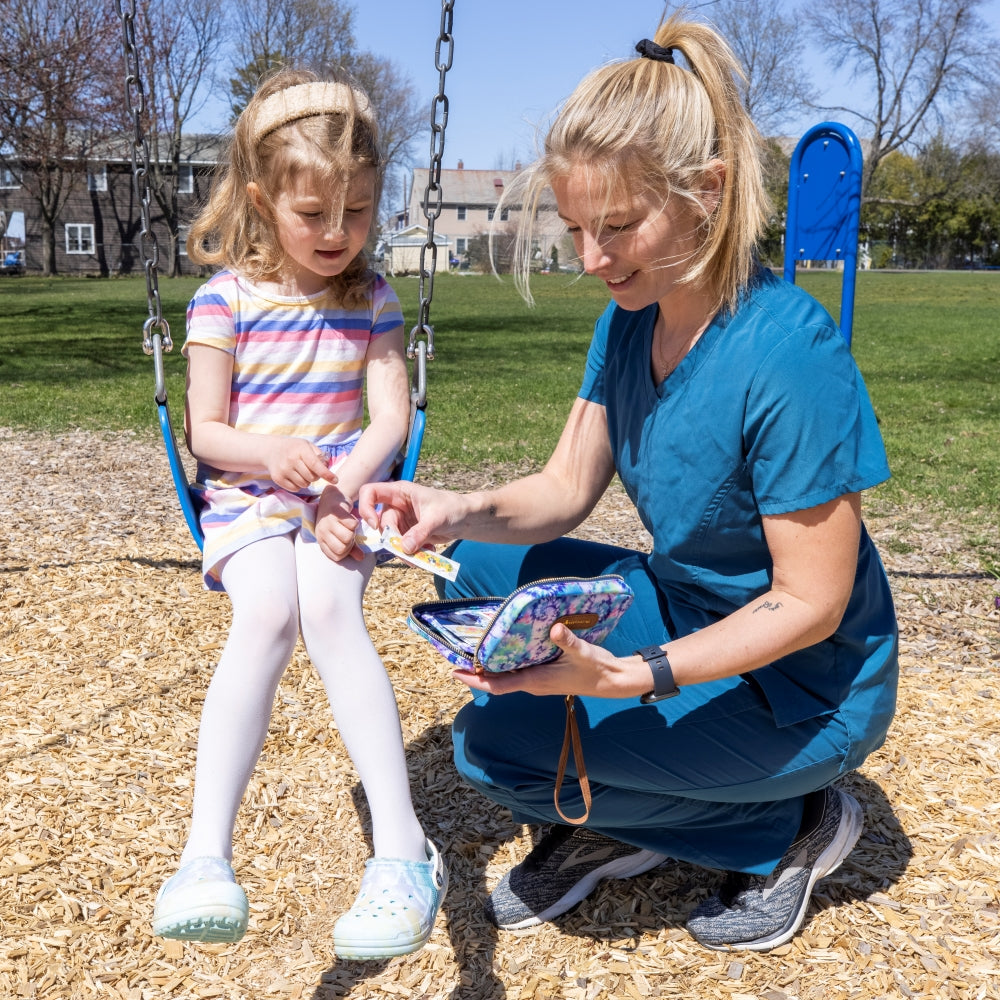Free Shipping over $49
Free Shipping over $49
First Aid Kits
Bandages

How to treat common summertime injuries on-the-go!
June 09, 2022 4 min read
School’s out, days are longer and kids are on the move more than usual during summer. With so many fun, adventurous activities to do, it’s no surprise that American emergency rooms see an uptick in daily visits during the warmer months, from kids and adults alike. We’ve gathered 3 common summer injuries and tips on how to treat them on your own so you can KEEP>GOING all summer long!
Sunburn:
One of the MOST popular — not to mention most painful — summer ailments is a sunburn. We all know how hard it is to keep your child lathered up with sunscreen all day, but boy is it important! Sometimes it can take 1-2 days for a burn to fully develop on the skin after exposure, then several more days after that for the burn to fully heal. There are a few key items found in our KEEP>GOING First Aid Kits that can help ease the pain and discomfort while the skin is healing:
- Relieve Pain. A topical pain treatment, like burn cream, can also be applied to the area. Pro-Tip: The First Aid burn cream packets in our kits have aloe in them, which helps to relieve pain, swelling and redness! Use this as soon as you notice a burn. An over-the-counter pain reliever like ibuprofen or aspirin can relieve discomfort as well as help to prevent inflammation When giving any type of medication to children, make sure to follow your doctor's recommendations on usage and dosage.
- Cool the skin. Keeping the injured area cool is very important. Run cool tap water over your burn several times a day to help reduce pain. If you are in an area where running water is not available, use the instant cold pack in your First Aid Kit. P.S. Don’t forget to reapply burn cream after each rinse, if desired.
- Drink up To avoid dehydration from sun exposure, be sure to keep your child hydrated with water. Note: There isn’t water in our first aid kits, but we ALWAYS recommend keeping a bottle of fresh, clean water with you at all times.
- Don’t pop the blisters. If blisters are present, and one does break, clean the area with mild soap and water, pat dry, apply triple antibiotic ointment and cover with a non-stick bandage. If you are on the go, clean with our non-sting antiseptic wipes.
- Don’t scratch As the skin heals and begins to peel, your child may feel very itchy in the affected area. To prevent scratching apply hydrocortisone cream!
- Stay out of the sun This one might be hard for your child, but keep them in the shade or keep the affected area sufficiently covered while the burn is healing to avoid further trauma.
If you don’t see improvement with these at-home care methods, or a burn is accompanied by nausea, chills, a fever, blistering, headache, or extreme pain, bring your child to the Emergency Department right away.
Rhus Dermatitis:
That’s a fancy way of saying a skin reaction caused by poison ivy, poison oak, poison sumac and the like. Most cases don’t require treatment by a doctor, though wide spread, heavily blistered cases should be seen by a professional. To treat a mild skin reaction:
- Clean. Wash the affected area with a mild soap, or use an antiseptic wipe from your KEEP>GOING First Aid Kit.
- Get rid of the itch. Apply hydrocortisone (anti-itch) cream to the area to prevent scratching and blister breakage.
- Treat. Taking oral antihistamines can also help to reduce itchiness, inflammation and discomfort.
- Soak. For relief, consider soaking the area in a cool bath with an oatmeal based soap (we like Aveeno).
- Cool it. You can also apply cool, wet compresses to the area for 15-30 minutes several times a day. P.S.Our SuperKits come with an instant cold pack, for when you are on the go. We also have the cutest gel ice packs made just for kids to make cooling time a little easier and more enjoyable.
This type of rash will typically heal on its own in 2-3 weeks.
Sprains:
A sprain is an injury to a ligament caused by torn fibers in the ligament. These tears can be small and partial or completely torn apart, depending on the severity of the injury. Sprains often swell up quickly and can be very painful. Typically, the more pain the more severe the injury is. For minor sprains, when the pain is tough but tolerable, you can try these healing methods on the go:
- Rest. Try not to use the ligament or put any weight on it for around 48-72 hours. In your SuperKit you’ll find a triangle bandage, which can be used to secure a ligament such as an arm to help reduce motion.
- Ice the area. To reduce swelling and inflammation, immediately apply a cold compress, like the instant cold pack in your First Aid Kit, to the area. Continue to ice for 15-20 minutes, 4-8 times a day for the next 48-72 hours.
- Compress. Wrap the injured ligament with an elastic wrap or bandage.
- Elevate. Keep the ligament lifted above the heart as often as possible to limit swelling and inflammation.
- Relieve. A pain reliever such as ibuprofen, aspirin or non-aspirin can aid in pain relief. All 3 can be found in your First Aid Kit.
As summer rolls on, be sure to bring your KEEP>GOING First Aid Kit with you everywhere you go for moments like these! Like this blog? Follow us on Instagram at @keepgoingfirstaid and like us on Facebook for tips and more!
KEEP>GOING!
The Pepper Family at KEEP>GOING First Aid
GET 10% OFF IMMEDIATELY
Subscribe to our Newsletter and receive a 10% coupon when you enter your e-mail address.








